Criminology and Behavioral Psychology Analysis
VerifiedAdded on 2021/04/24
|8
|1518
|67
AI Summary
The provided document is a solved assignment that delves into the realm of criminology and behavioral psychology. It examines two distinct theoretical frameworks - psychological theory and sociological theory - which attempt to explain the phenomenon of crime. The discussion centers around how these theories, individually and collectively, provide insights into the nature and behavior of criminal offenses such as fast driving, over speeding, booze driving, and fatal accidents.
Contribute Materials
Your contribution can guide someone’s learning journey. Share your
documents today.
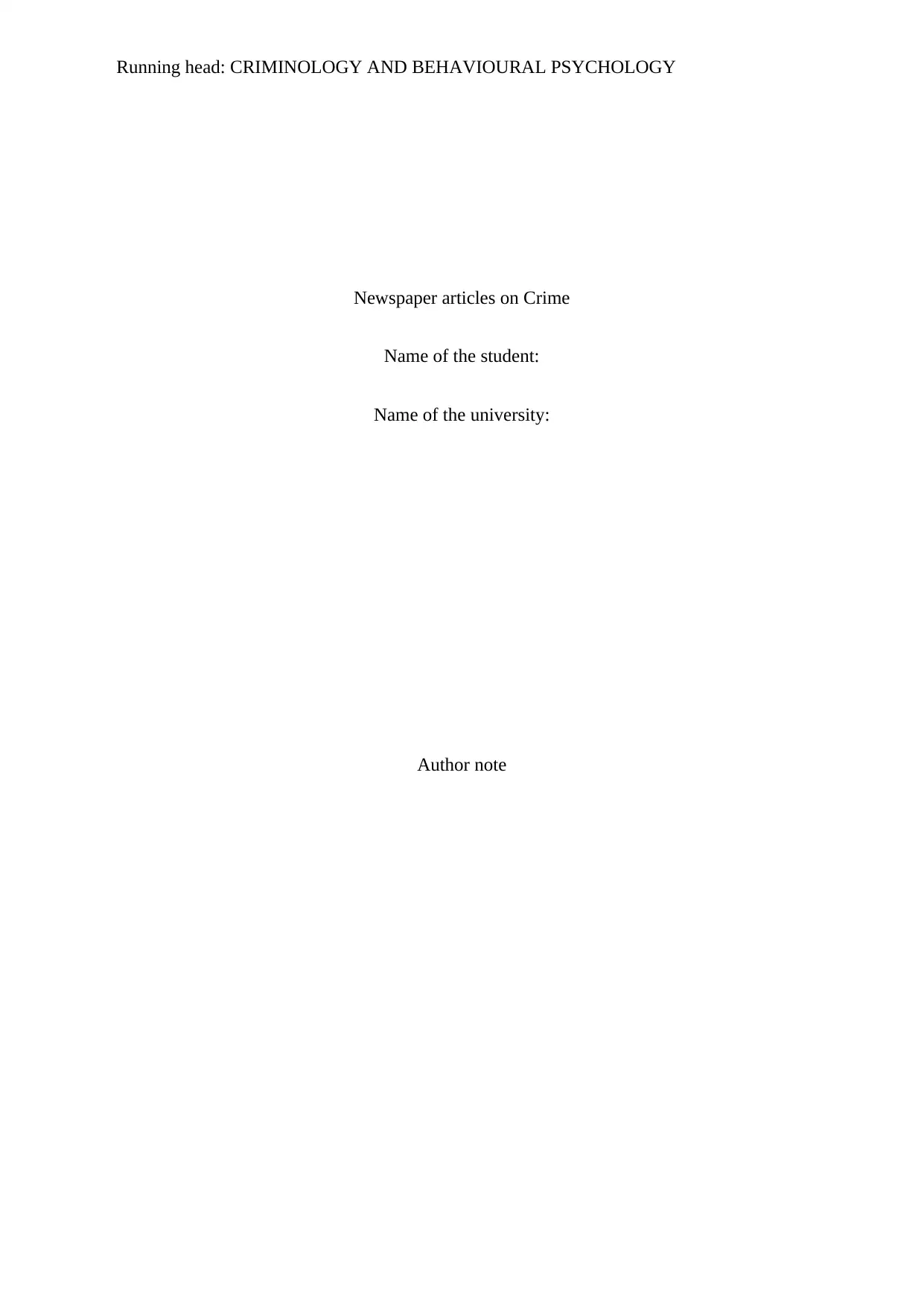
Running head: CRIMINOLOGY AND BEHAVIOURAL PSYCHOLOGY
Newspaper articles on Crime
Name of the student:
Name of the university:
Author note
Newspaper articles on Crime
Name of the student:
Name of the university:
Author note
Secure Best Marks with AI Grader
Need help grading? Try our AI Grader for instant feedback on your assignments.
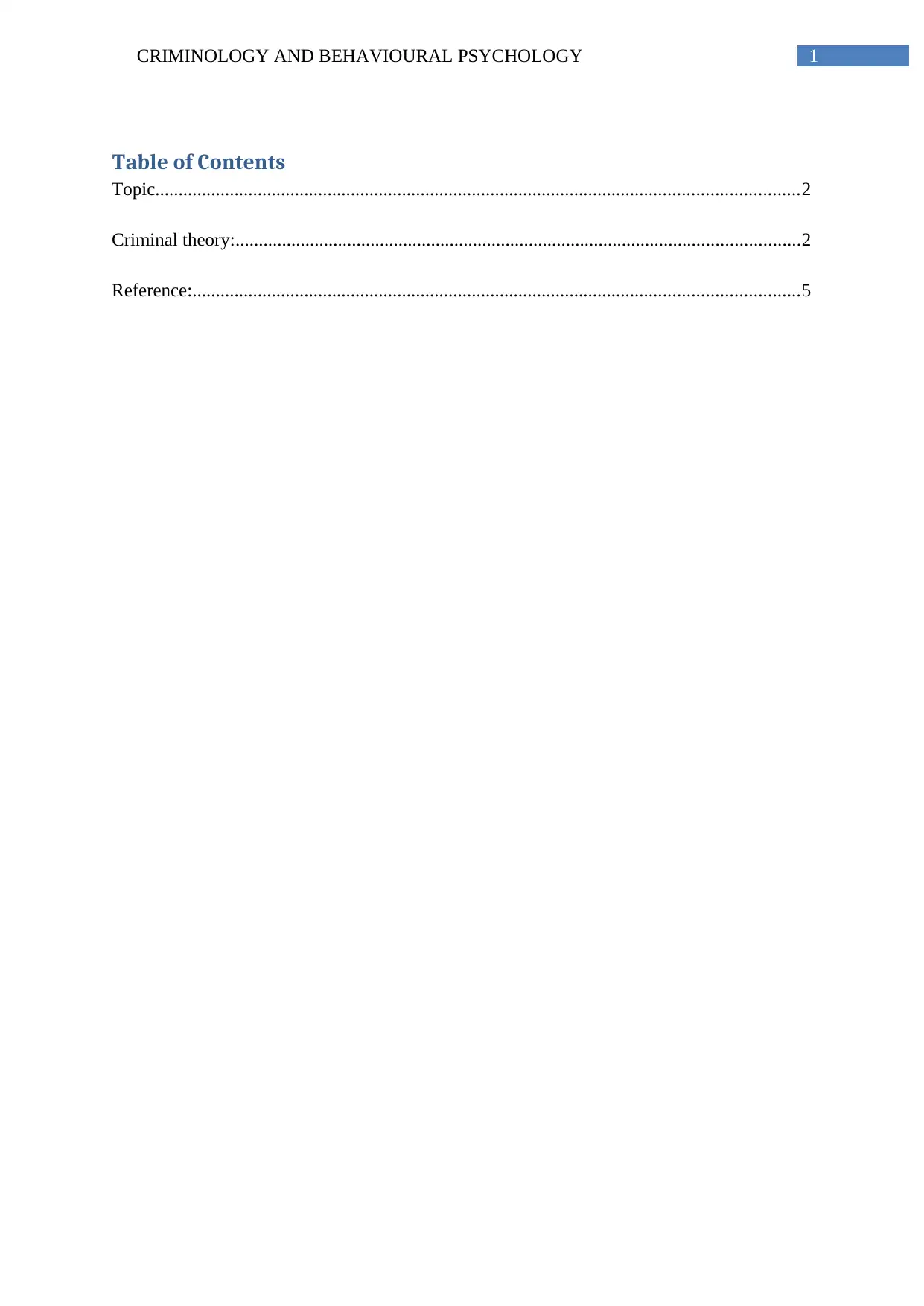
1CRIMINOLOGY AND BEHAVIOURAL PSYCHOLOGY
Table of Contents
Topic..........................................................................................................................................2
Criminal theory:.........................................................................................................................2
Reference:..................................................................................................................................5
Table of Contents
Topic..........................................................................................................................................2
Criminal theory:.........................................................................................................................2
Reference:..................................................................................................................................5
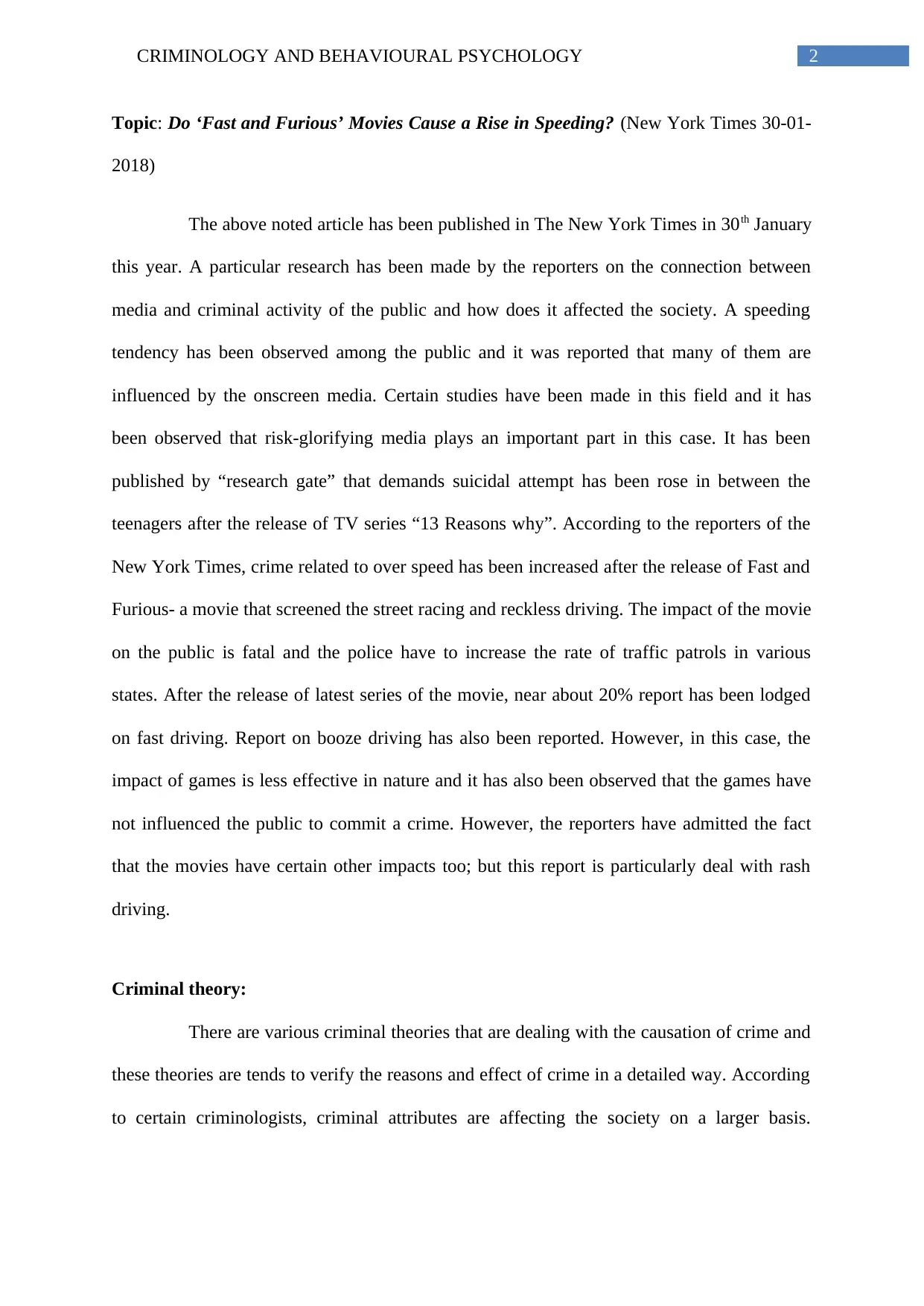
2CRIMINOLOGY AND BEHAVIOURAL PSYCHOLOGY
Topic: Do ‘Fast and Furious’ Movies Cause a Rise in Speeding? (New York Times 30-01-
2018)
The above noted article has been published in The New York Times in 30th January
this year. A particular research has been made by the reporters on the connection between
media and criminal activity of the public and how does it affected the society. A speeding
tendency has been observed among the public and it was reported that many of them are
influenced by the onscreen media. Certain studies have been made in this field and it has
been observed that risk-glorifying media plays an important part in this case. It has been
published by “research gate” that demands suicidal attempt has been rose in between the
teenagers after the release of TV series “13 Reasons why”. According to the reporters of the
New York Times, crime related to over speed has been increased after the release of Fast and
Furious- a movie that screened the street racing and reckless driving. The impact of the movie
on the public is fatal and the police have to increase the rate of traffic patrols in various
states. After the release of latest series of the movie, near about 20% report has been lodged
on fast driving. Report on booze driving has also been reported. However, in this case, the
impact of games is less effective in nature and it has also been observed that the games have
not influenced the public to commit a crime. However, the reporters have admitted the fact
that the movies have certain other impacts too; but this report is particularly deal with rash
driving.
Criminal theory:
There are various criminal theories that are dealing with the causation of crime and
these theories are tends to verify the reasons and effect of crime in a detailed way. According
to certain criminologists, criminal attributes are affecting the society on a larger basis.
Topic: Do ‘Fast and Furious’ Movies Cause a Rise in Speeding? (New York Times 30-01-
2018)
The above noted article has been published in The New York Times in 30th January
this year. A particular research has been made by the reporters on the connection between
media and criminal activity of the public and how does it affected the society. A speeding
tendency has been observed among the public and it was reported that many of them are
influenced by the onscreen media. Certain studies have been made in this field and it has
been observed that risk-glorifying media plays an important part in this case. It has been
published by “research gate” that demands suicidal attempt has been rose in between the
teenagers after the release of TV series “13 Reasons why”. According to the reporters of the
New York Times, crime related to over speed has been increased after the release of Fast and
Furious- a movie that screened the street racing and reckless driving. The impact of the movie
on the public is fatal and the police have to increase the rate of traffic patrols in various
states. After the release of latest series of the movie, near about 20% report has been lodged
on fast driving. Report on booze driving has also been reported. However, in this case, the
impact of games is less effective in nature and it has also been observed that the games have
not influenced the public to commit a crime. However, the reporters have admitted the fact
that the movies have certain other impacts too; but this report is particularly deal with rash
driving.
Criminal theory:
There are various criminal theories that are dealing with the causation of crime and
these theories are tends to verify the reasons and effect of crime in a detailed way. According
to certain criminologists, criminal attributes are affecting the society on a larger basis.

3CRIMINOLOGY AND BEHAVIOURAL PSYCHOLOGY
Psychology of a human being is playing an important part in this case and circumstances are
linked with these psychological approaches to certain extent (Cornish & Clarke, 2014).
The current topic is based on two criminal approaches such as psychological theory
and sociological theory. The thoughts and reaction of the criminals are covering under the
purview of psychological theory. It is a well-known object that psychological theory is based
on three sub-theories such as psychodynamic theory, behavioral theory and cognitive theory
(“IResearchNet", 2018). Apart from these, there are certain other theories like developmental
theories, grand theories and social psychological theories that can also define crime and
criminal behavior (Farrington, 2017). According to the psychodynamic theory, human
unconsciousness is the basic ingredient of criminal activities. For an example, most of the
criminals have disturbed childhood experiences and that affects their adult life and influenced
them to commit crime. On the other hand, the behavioral theory has made an approach to
define the reason of crime from the aspect of interaction with environment. In the words of
certain criminologists like Watson, behavioral theory is the outcome of experience (Gross,
2015). It has been pointed out under this theory that human kinds are imitating the facts
which seems interesting to them. Those acts are, in certain circumstances; control the activity
of the person. According to M P Feldman, learning plays an important role in the explanation
of criminal behavior. Diener had explained the theory from an important aspect. According to
him, when a person learnt something bad, he does not think about the outcome. He lost his
self-consciousness while applying the illegal acts and the acts change his behavioral approach
(DeLisi & Vaughn, 2014). In this case, it has been observed that the public are influenced by
certain risk generating movies and applied these to their real life. In the light of this theory, it
can be stated that the people, who are watching such movies often lost their sense and try to
apply all the onscreen stunts in their real life.
Psychology of a human being is playing an important part in this case and circumstances are
linked with these psychological approaches to certain extent (Cornish & Clarke, 2014).
The current topic is based on two criminal approaches such as psychological theory
and sociological theory. The thoughts and reaction of the criminals are covering under the
purview of psychological theory. It is a well-known object that psychological theory is based
on three sub-theories such as psychodynamic theory, behavioral theory and cognitive theory
(“IResearchNet", 2018). Apart from these, there are certain other theories like developmental
theories, grand theories and social psychological theories that can also define crime and
criminal behavior (Farrington, 2017). According to the psychodynamic theory, human
unconsciousness is the basic ingredient of criminal activities. For an example, most of the
criminals have disturbed childhood experiences and that affects their adult life and influenced
them to commit crime. On the other hand, the behavioral theory has made an approach to
define the reason of crime from the aspect of interaction with environment. In the words of
certain criminologists like Watson, behavioral theory is the outcome of experience (Gross,
2015). It has been pointed out under this theory that human kinds are imitating the facts
which seems interesting to them. Those acts are, in certain circumstances; control the activity
of the person. According to M P Feldman, learning plays an important role in the explanation
of criminal behavior. Diener had explained the theory from an important aspect. According to
him, when a person learnt something bad, he does not think about the outcome. He lost his
self-consciousness while applying the illegal acts and the acts change his behavioral approach
(DeLisi & Vaughn, 2014). In this case, it has been observed that the public are influenced by
certain risk generating movies and applied these to their real life. In the light of this theory, it
can be stated that the people, who are watching such movies often lost their sense and try to
apply all the onscreen stunts in their real life.
Secure Best Marks with AI Grader
Need help grading? Try our AI Grader for instant feedback on your assignments.
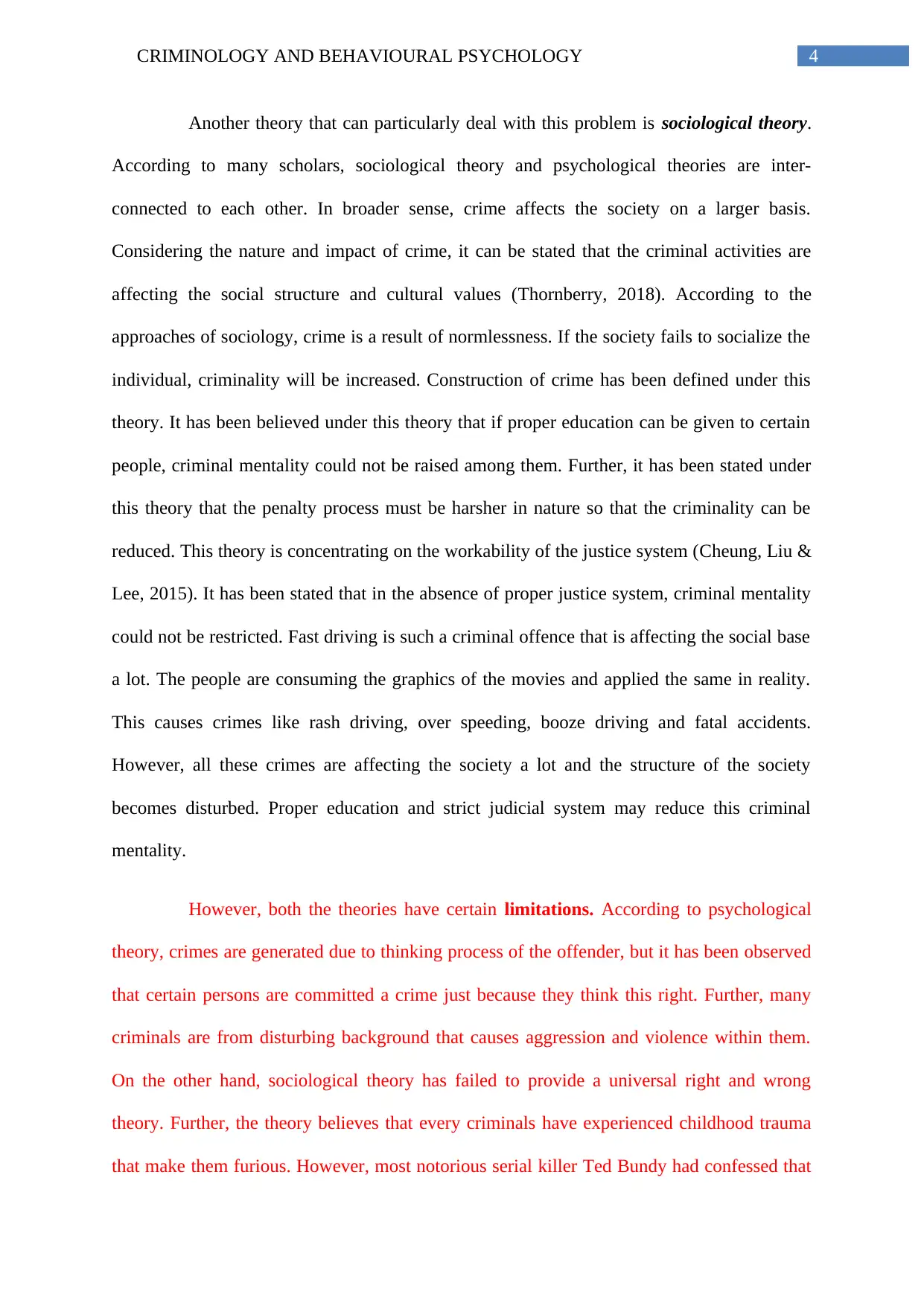
4CRIMINOLOGY AND BEHAVIOURAL PSYCHOLOGY
Another theory that can particularly deal with this problem is sociological theory.
According to many scholars, sociological theory and psychological theories are inter-
connected to each other. In broader sense, crime affects the society on a larger basis.
Considering the nature and impact of crime, it can be stated that the criminal activities are
affecting the social structure and cultural values (Thornberry, 2018). According to the
approaches of sociology, crime is a result of normlessness. If the society fails to socialize the
individual, criminality will be increased. Construction of crime has been defined under this
theory. It has been believed under this theory that if proper education can be given to certain
people, criminal mentality could not be raised among them. Further, it has been stated under
this theory that the penalty process must be harsher in nature so that the criminality can be
reduced. This theory is concentrating on the workability of the justice system (Cheung, Liu &
Lee, 2015). It has been stated that in the absence of proper justice system, criminal mentality
could not be restricted. Fast driving is such a criminal offence that is affecting the social base
a lot. The people are consuming the graphics of the movies and applied the same in reality.
This causes crimes like rash driving, over speeding, booze driving and fatal accidents.
However, all these crimes are affecting the society a lot and the structure of the society
becomes disturbed. Proper education and strict judicial system may reduce this criminal
mentality.
However, both the theories have certain limitations. According to psychological
theory, crimes are generated due to thinking process of the offender, but it has been observed
that certain persons are committed a crime just because they think this right. Further, many
criminals are from disturbing background that causes aggression and violence within them.
On the other hand, sociological theory has failed to provide a universal right and wrong
theory. Further, the theory believes that every criminals have experienced childhood trauma
that make them furious. However, most notorious serial killer Ted Bundy had confessed that
Another theory that can particularly deal with this problem is sociological theory.
According to many scholars, sociological theory and psychological theories are inter-
connected to each other. In broader sense, crime affects the society on a larger basis.
Considering the nature and impact of crime, it can be stated that the criminal activities are
affecting the social structure and cultural values (Thornberry, 2018). According to the
approaches of sociology, crime is a result of normlessness. If the society fails to socialize the
individual, criminality will be increased. Construction of crime has been defined under this
theory. It has been believed under this theory that if proper education can be given to certain
people, criminal mentality could not be raised among them. Further, it has been stated under
this theory that the penalty process must be harsher in nature so that the criminality can be
reduced. This theory is concentrating on the workability of the justice system (Cheung, Liu &
Lee, 2015). It has been stated that in the absence of proper justice system, criminal mentality
could not be restricted. Fast driving is such a criminal offence that is affecting the social base
a lot. The people are consuming the graphics of the movies and applied the same in reality.
This causes crimes like rash driving, over speeding, booze driving and fatal accidents.
However, all these crimes are affecting the society a lot and the structure of the society
becomes disturbed. Proper education and strict judicial system may reduce this criminal
mentality.
However, both the theories have certain limitations. According to psychological
theory, crimes are generated due to thinking process of the offender, but it has been observed
that certain persons are committed a crime just because they think this right. Further, many
criminals are from disturbing background that causes aggression and violence within them.
On the other hand, sociological theory has failed to provide a universal right and wrong
theory. Further, the theory believes that every criminals have experienced childhood trauma
that make them furious. However, most notorious serial killer Ted Bundy had confessed that
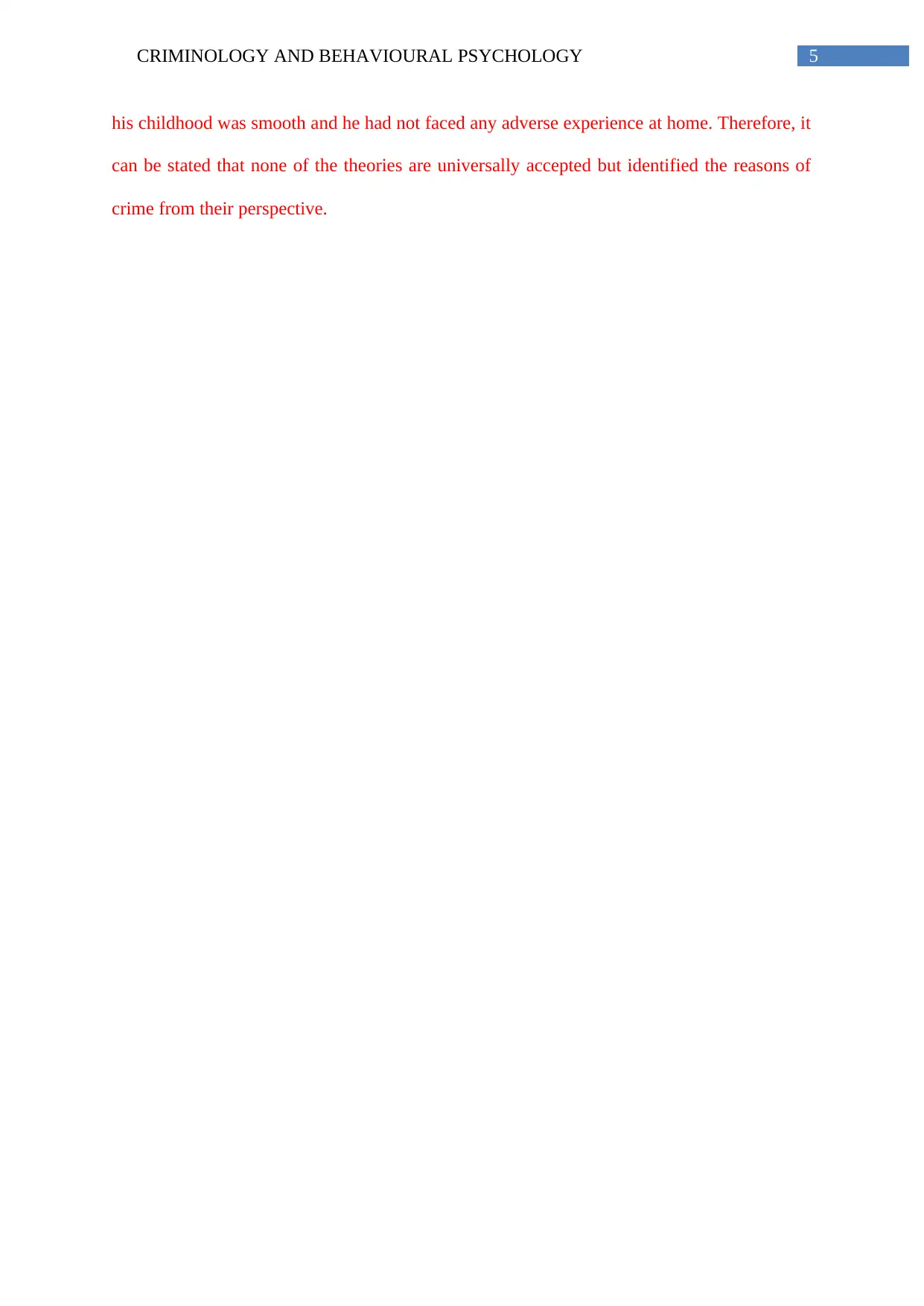
5CRIMINOLOGY AND BEHAVIOURAL PSYCHOLOGY
his childhood was smooth and he had not faced any adverse experience at home. Therefore, it
can be stated that none of the theories are universally accepted but identified the reasons of
crime from their perspective.
his childhood was smooth and he had not faced any adverse experience at home. Therefore, it
can be stated that none of the theories are universally accepted but identified the reasons of
crime from their perspective.
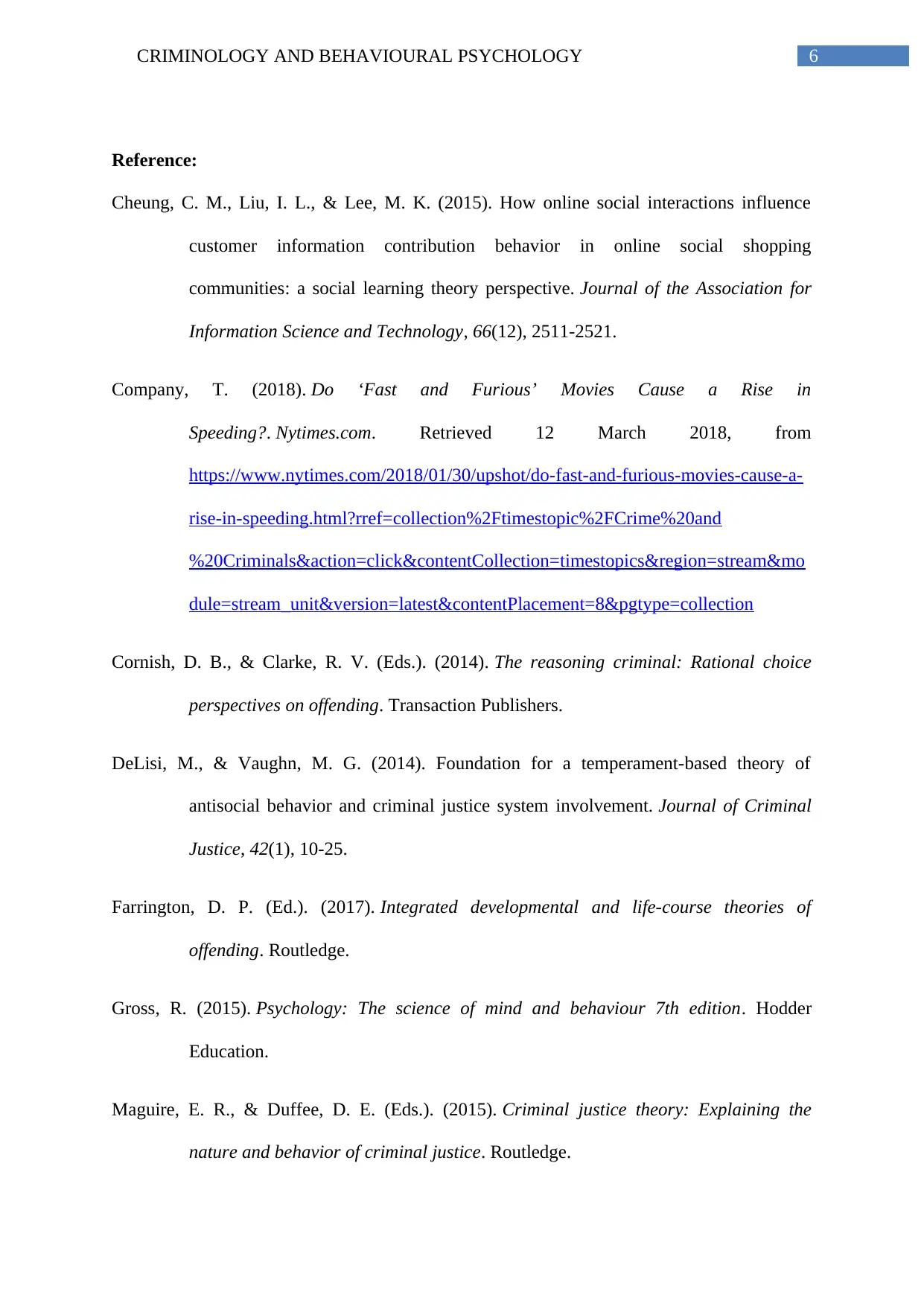
6CRIMINOLOGY AND BEHAVIOURAL PSYCHOLOGY
Reference:
Cheung, C. M., Liu, I. L., & Lee, M. K. (2015). How online social interactions influence
customer information contribution behavior in online social shopping
communities: a social learning theory perspective. Journal of the Association for
Information Science and Technology, 66(12), 2511-2521.
Company, T. (2018). Do ‘Fast and Furious’ Movies Cause a Rise in
Speeding?. Nytimes.com. Retrieved 12 March 2018, from
https://www.nytimes.com/2018/01/30/upshot/do-fast-and-furious-movies-cause-a-
rise-in-speeding.html?rref=collection%2Ftimestopic%2FCrime%20and
%20Criminals&action=click&contentCollection=timestopics®ion=stream&mo
dule=stream_unit&version=latest&contentPlacement=8&pgtype=collection
Cornish, D. B., & Clarke, R. V. (Eds.). (2014). The reasoning criminal: Rational choice
perspectives on offending. Transaction Publishers.
DeLisi, M., & Vaughn, M. G. (2014). Foundation for a temperament-based theory of
antisocial behavior and criminal justice system involvement. Journal of Criminal
Justice, 42(1), 10-25.
Farrington, D. P. (Ed.). (2017). Integrated developmental and life-course theories of
offending. Routledge.
Gross, R. (2015). Psychology: The science of mind and behaviour 7th edition. Hodder
Education.
Maguire, E. R., & Duffee, D. E. (Eds.). (2015). Criminal justice theory: Explaining the
nature and behavior of criminal justice. Routledge.
Reference:
Cheung, C. M., Liu, I. L., & Lee, M. K. (2015). How online social interactions influence
customer information contribution behavior in online social shopping
communities: a social learning theory perspective. Journal of the Association for
Information Science and Technology, 66(12), 2511-2521.
Company, T. (2018). Do ‘Fast and Furious’ Movies Cause a Rise in
Speeding?. Nytimes.com. Retrieved 12 March 2018, from
https://www.nytimes.com/2018/01/30/upshot/do-fast-and-furious-movies-cause-a-
rise-in-speeding.html?rref=collection%2Ftimestopic%2FCrime%20and
%20Criminals&action=click&contentCollection=timestopics®ion=stream&mo
dule=stream_unit&version=latest&contentPlacement=8&pgtype=collection
Cornish, D. B., & Clarke, R. V. (Eds.). (2014). The reasoning criminal: Rational choice
perspectives on offending. Transaction Publishers.
DeLisi, M., & Vaughn, M. G. (2014). Foundation for a temperament-based theory of
antisocial behavior and criminal justice system involvement. Journal of Criminal
Justice, 42(1), 10-25.
Farrington, D. P. (Ed.). (2017). Integrated developmental and life-course theories of
offending. Routledge.
Gross, R. (2015). Psychology: The science of mind and behaviour 7th edition. Hodder
Education.
Maguire, E. R., & Duffee, D. E. (Eds.). (2015). Criminal justice theory: Explaining the
nature and behavior of criminal justice. Routledge.
Paraphrase This Document
Need a fresh take? Get an instant paraphrase of this document with our AI Paraphraser
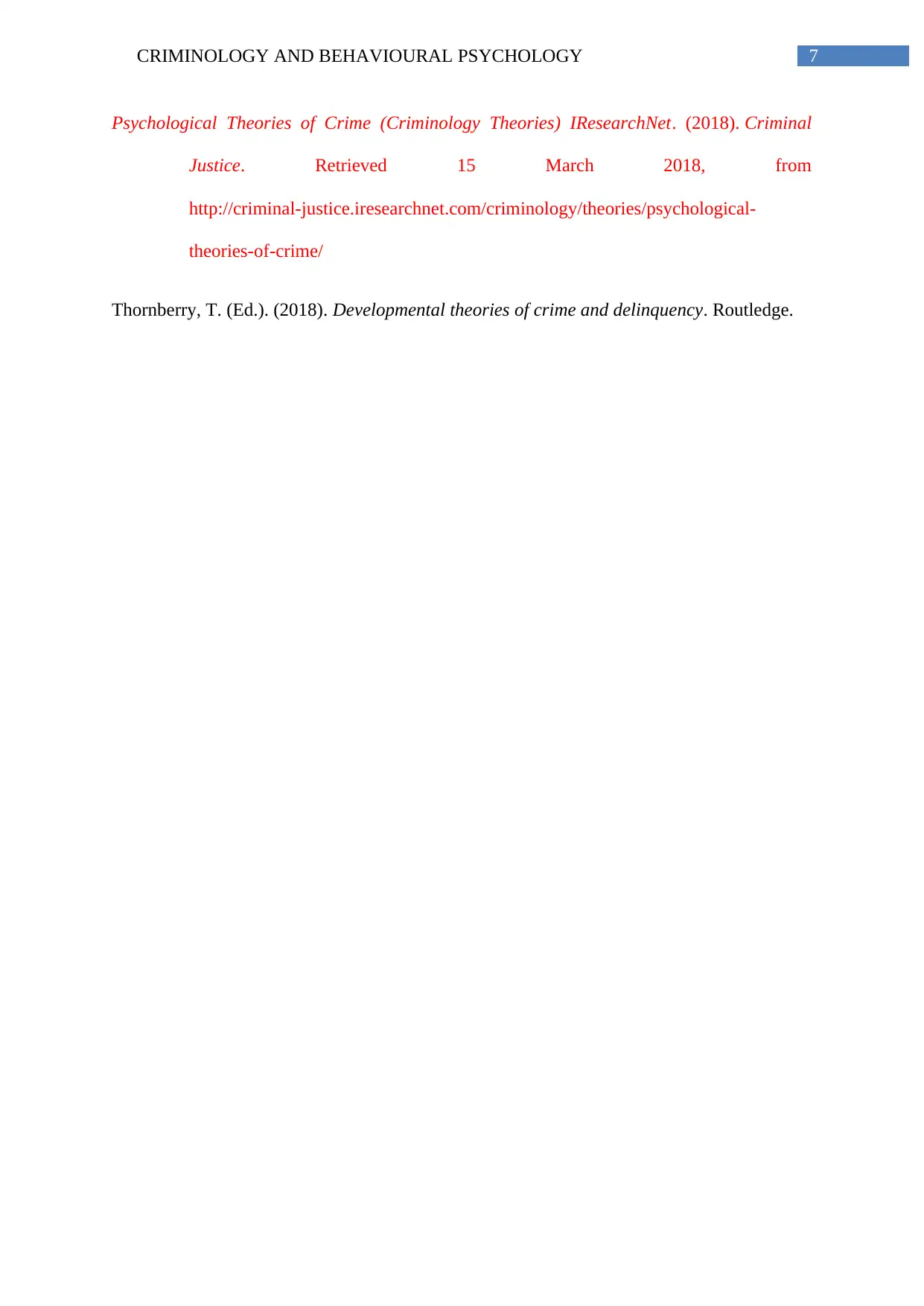
7CRIMINOLOGY AND BEHAVIOURAL PSYCHOLOGY
Psychological Theories of Crime (Criminology Theories) IResearchNet. (2018). Criminal
Justice. Retrieved 15 March 2018, from
http://criminal-justice.iresearchnet.com/criminology/theories/psychological-
theories-of-crime/
Thornberry, T. (Ed.). (2018). Developmental theories of crime and delinquency. Routledge.
Psychological Theories of Crime (Criminology Theories) IResearchNet. (2018). Criminal
Justice. Retrieved 15 March 2018, from
http://criminal-justice.iresearchnet.com/criminology/theories/psychological-
theories-of-crime/
Thornberry, T. (Ed.). (2018). Developmental theories of crime and delinquency. Routledge.
1 out of 8
Your All-in-One AI-Powered Toolkit for Academic Success.
+13062052269
info@desklib.com
Available 24*7 on WhatsApp / Email
![[object Object]](/_next/static/media/star-bottom.7253800d.svg)
Unlock your academic potential
© 2024 | Zucol Services PVT LTD | All rights reserved.


